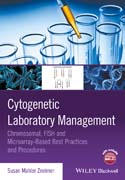
Cytogenetic Laboratory Management: Chromosomal, FISH and Microarray-Based Best Practices and Standard Operating Procedures
Zneimer, Susan Mahler
INDICE: Dedication .Preface .Acknowledgments .Part I: Best Practices for Laboratory Operations .Chapter 1: Guidelines for Good Clinical Laboratory Practice .1.1. Physical facilities .1.2. Specimen transport and management .1.3. Personnel safety .1.4. Laboratory information system .1.5. Quality management .1.6. Organization and personnel .1.7. Laboratory equipment .1.8. Testing operating procedures .1.9. Safety Plan .1.10. Biosafety Plan .1.11. Chemical Hygiene Plan .1.12. HIPAA Incident Plan .References .Chapter 2: Quality Management .2.1. Quality control program .2.2. Individualized quality control plan (IQCP) .2.3. Standards for test records and reporting .2.4. Overview of general culturing issues .2.5. Quality improvement program .2.6. Proficiency testing .2.7. Inspection preparation .2.8. Calibration verification .References .Chapter 3: Design Control of Tests and FDA Guidelines for Laboratory Developed Tests (LDTs) .3.1. Design control of tests .3.2. FDA guideline summary for laboratory developed tests (LDTs) .References .Chapter 4: Pre–Clinical Validation Studies .4.1. Validation plans and protocols .4.2. Validation reports .4.3. Example validation plan and report – FISH probes for chromosome 5 deletion and monosomy .4.4. Example validation plan and report FDA approved Vysis ALK FISH probe .References .Chapter 5: Reagents, Instruments and Equipment .5.1. IQ, OQ, PQ procedures .5.2. Reagents, verification for clinical use and media preparation .5.3. Equipment and instruments .References .PART II – Best Practices for Staffing and Training .Chapter 6: Cost of Testing and Staffing Requirements .6.1. Labor costs .6.2. Time and cost assessment .6.3. Staffing hiring needs .6.4. Staff task requirements .References .Chapter 7: Process Improvement – Six Sigma Approach to Laboratory Improvement .7.1. Introduction .7.2. DMAIIC Tools .7.3. Defining the project .7.4. Measuring variables .7.5. Analyze data for the project .7.6. Innovate and improve the project .7.7. Controlling the results of the project .References .Chapter 8: Staff Training and Competency for a Cytogenetics laboratory .8.1. Technician (non–licensed/certified lab personnel) training and competency .8.2. Technologist (licensed/ASCP certified) training and competency .8.3. General supervisor/manager training and competency .8.4. Cytogenetic technical supervisor/director training and competency .References .Chapter 9: Training Program for Cytogenetic and FISH Technologists .9.1. Training program overview and objectives .9.2. Program content .9.3. Practical component of the training program .9.4. Lectures, quizzes and assignments .9.5. Trainee competency and completion of the program .9.6. Trainee handbook .9.7. Logs, competency forms and evaluations forms .References .Chapter 10: Training Program for Molecular Genetic Technologists .10.1. Training overview .10.2. Training objectives .10.3. Complete program content .10.4. Validation of trainee competency .10.5. Trainee handbook .10.6. Logs, competency forms and evaluations forms .References .PART III – Standard Operating Procedures .Chapter 11: General SOP Information by test and Pre–analytic procedures .11.1. Definition of an SOP .11.2. Template for an SOP .11.3. CAP and ACMG guidelines for writing SOPs .11.4. Accessioning specimens .References .Chapter 12: Analytic Procedures – Chromosome Analysis .12.1. Peripheral blood and PUBS for constitutional disorders .12.2. Amniotic fluid specimens .12.3. Chorionic villus sampling .12.4. Solid tissue samples: tissue biopsies and products of conception .12.5. Bone marrow and blood for hematologic diseases .12.6. Lymph nodes and solid tumors .12.7. Breakage syndromes .References .Chapter 13: Analytic Procedures – FISH Analysis .13.1. General information .13.2. Metaphase versus interphase FISH analyses .13.3. Cell sorting for plasma cell dysplasia s for FISH analysis .13.4. General procedure for direct labeling of FISH probes .13.5. Prenatal multicolor probes .13.6. ToTelVysion Multi–color DNA Probe Mixtures .13.7. Multicolor–telomere, centromeres and paint probes .13.8. Microscope analysis for metaphase scoring .13.9. Microscope analysis for interphase scoring .13.10. Formalin fixed paraffin embedded procedure for FISH analysis .13.11. Her2 testing .13.12. UroVysion bladder cancer FISH Analysis .References .Chapter 14: Analytic Procedures Microarrays .14.1. Test Principle .14.2. Comparing conventional chromosome analysis, FISH analysis with chromosomal microarray analysis .14.3. Interpretation .14.4. Procedure Overview .References .Chapter 15: Post–analytic procedures .15.1. Reviewing and reporting cases for chromosome analysis .15.2. Reviewing and reporting cases for FISH analysis .15.3. Reviewing and reporting cases for microarrays .15.4. Procedure for avoidance and detection of clerical errors post reporting .15.5. Specimen, Material and Record Retention and Specimen Disposal .References .Glossary .Index
- ISBN: 978-1-119-06974-4
- Editorial: Wiley–Blackwell
- Encuadernacion: Rústica
- Páginas: 768
- Fecha Publicación: 07/11/2016
- Nº Volúmenes: 1
- Idioma: Inglés
